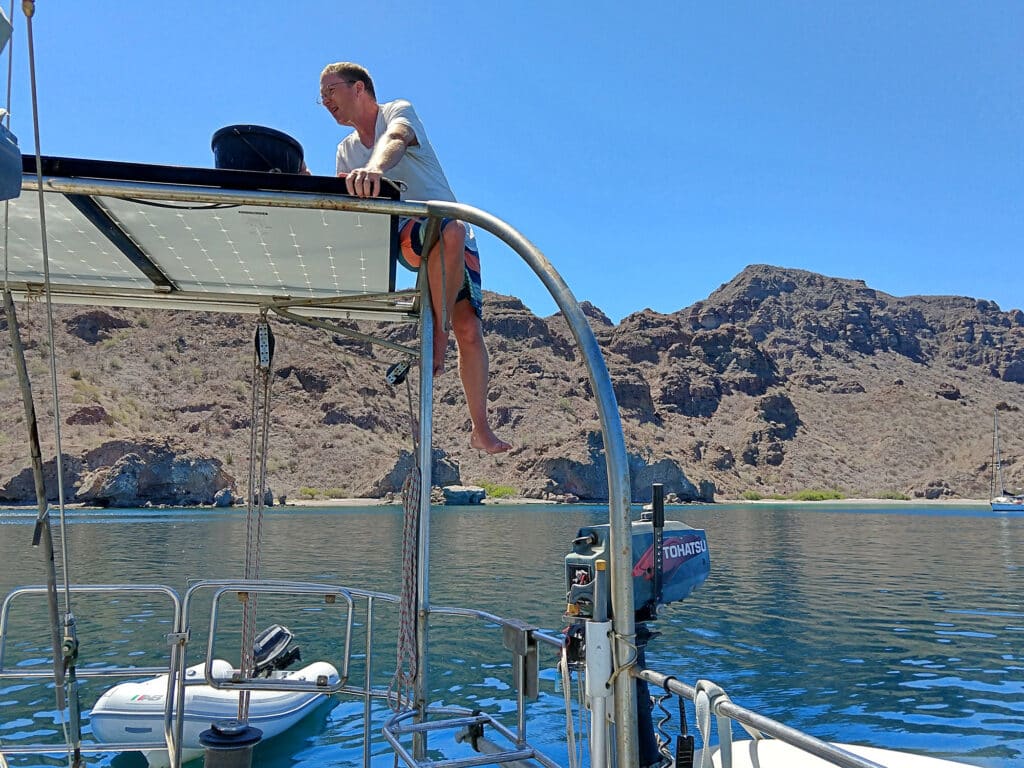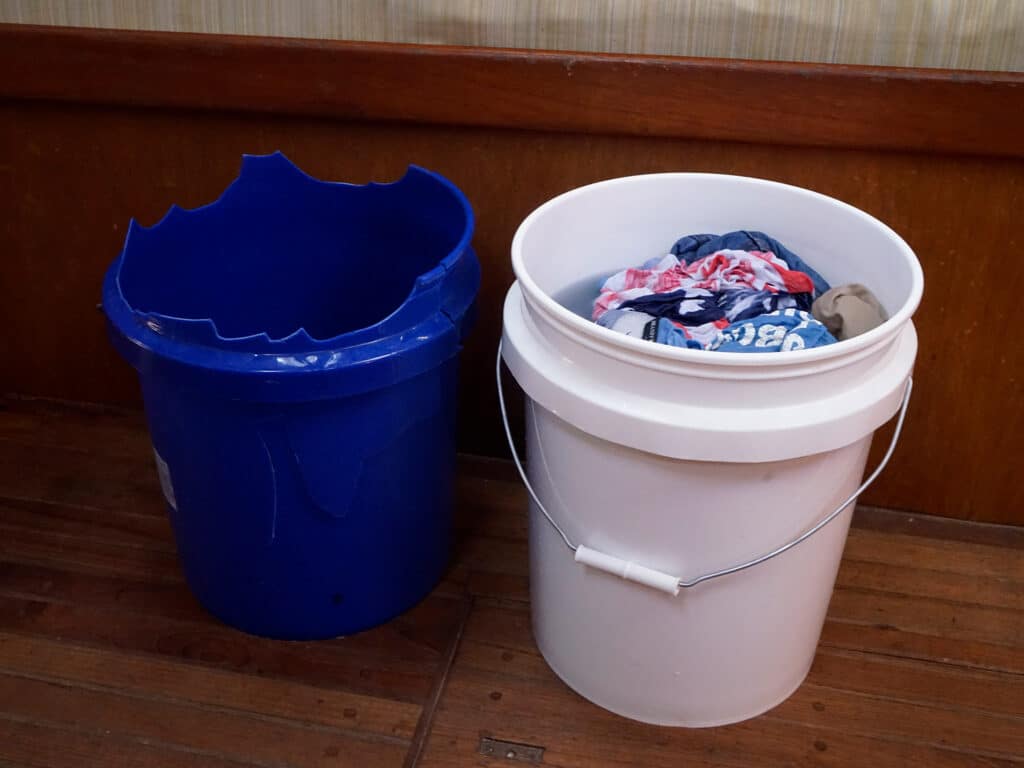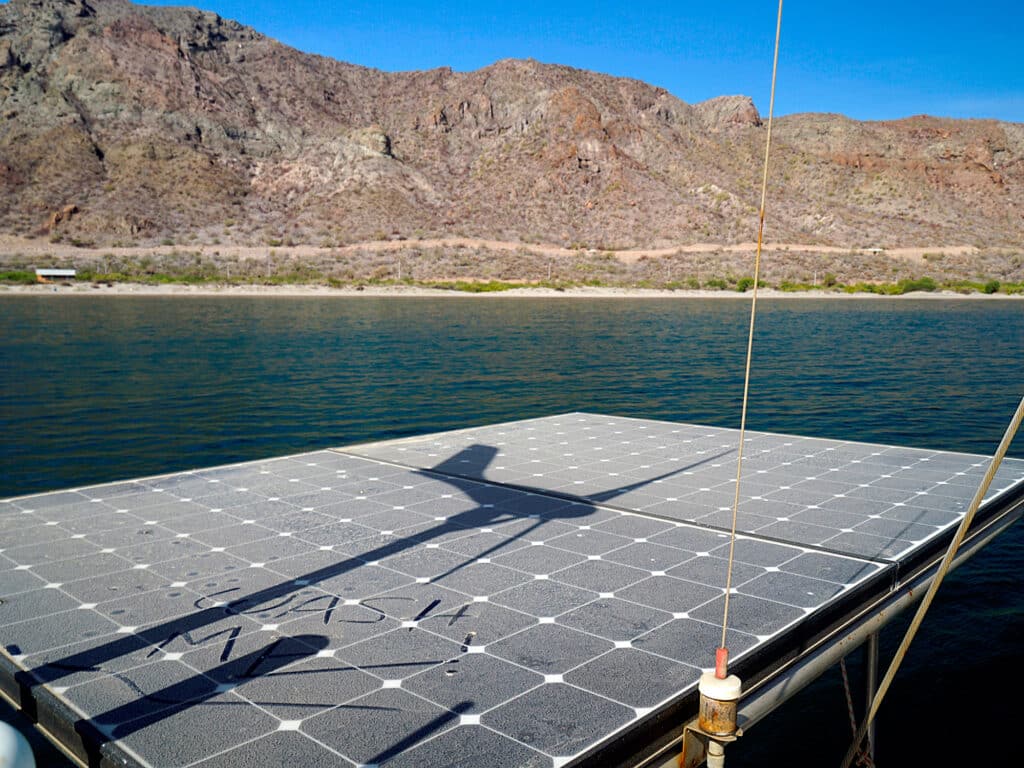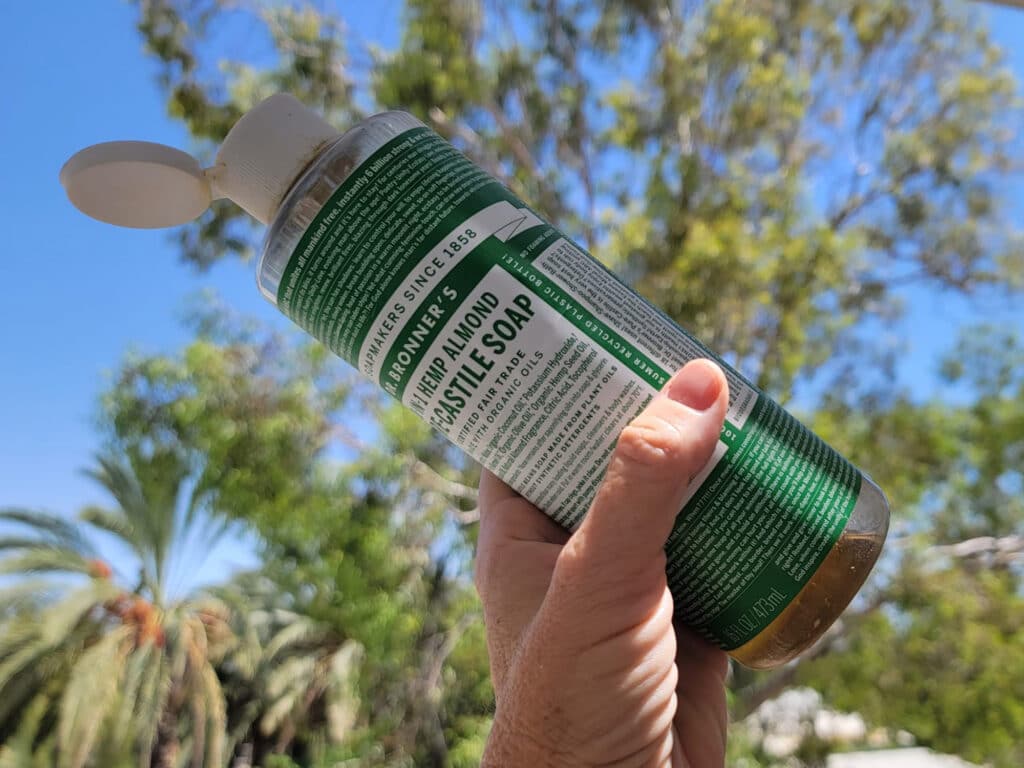
We’ve been asked recently: What do you do to keep your cruising sailboat clean? What routines do you have for liveaboard boat cleaning?
On Totem we have two basic principles:
- Keep the approach simple and effective, because there are a lot of other things we’d prefer to spend our time doing than cleaning the boat.
- Prioritize environmentally friendly cleaning products, for reasons that shouldn’t need explaining.
Cleaning Tools
We have far fewer cleaning tools on the boat than we did in our house—and almost all run on elbow grease instead of electricity.
Vacuum: A rechargeable handheld model like this works for us; other friends swear by their more powerful, compact Dyson model.
Whisk broom and dustpan: These are often easier to grab than the vacuum.
Buckets: There’s always a 5-gallon bucket or two on board, and often a smaller bucket as well. Nesting bowls from the galley can get called into service too.
Scrub brushes: A brush around the size of your hand works for most below-deck needs; we keep a couple of wider brushes for deck scrubbing. A small brush, like a toothbrush or nail brush, is useful for getting into small or awkward spots.
Sponges: For generally cleaning, two all-stars: extra-thirsty sponges, like these big carwash sponges, for soaking after sluicing, and Swedish dishcloths (thin sponges, actually, made from cotton and cellulose), which are great for everyday wiping up, and they’re biodegradable.
Cotton rags: We use them to wipe, polish and dry. Old T-shirts are great, and so is terry cloth. Avoid using microfiber rags because they add microplastics to the water.
Great multitool: Use this telescoping handle with interchangeable attachments to be a mop, brush or boat hook.
Notice the dearth of long handles? We’re just not that big of a boat, which translates to doing fine with the smaller stuff and working with the available storage aboard.

Making environmentally friendly choices is harder than it should be because there is no regulation in using terms such as biodegradable, nontoxic or natural. Brands can use any terms to their liking without consequence, and the cleaning industry is full of greenwashing. That’s just one reason we like to lean on cleaning products that are based on simple ingredients we can more readily supply.
You might like choosing brands that prioritize environmental friendliness versus the DIY cleaner approach for keeping a cruising boat clean. That’s cool! Do your research and try multiple, environmentally safe products when you have access to them; not all brands will be available once you sail away. You might be in a place where environmentally friendly products are available, but this was not the case in most places we’ve sailed. We’ve found that what’s readily available are products from multinational brands thinking about profit, not the planet.

Basic Cleaning Kit
Here’s a quick list of ingredients that stocks an effective cleaning kit on board. Most are widely available. Another great advantage of this slimmed-down cleaning approach, beyond being liberated from brands and radically reducing packaging? Freeing up precious storage space from the array of products you thought you needed!
Vinegar: Great for cleaning, disinfecting, deodorizing, deterring mold or mildew…the wonder ingredient for all-purpose cleaning.
Baking soda: Shake it on straight for scrubbing. Like vinegar, it is shockingly multipurpose on board, and like vinegar (which we keep in gallons on board), you can store it in bulk.
Borax: Similar to baking soda but more alkaline, making it a harsher option. I tend to default to using baking soda. In the mixes below, they are nearly interchangeable. Use slightly less borax. Some folks swear by borax for its strength.
Biodegradable liquid soap: There are many options and bulk packaging. Dr. Bronner’s (castile or Sal Suds) is widely recognized, but it falls into that “hard to find once you leave” category. If you can’t find any, swap phosphorus-free liquid dish soap or use borax and water. Note: Don’t mix castile soap in a vinegar or other acidic solution; they counteract each other (makes sense when you think about it: acid versus alkaline), and the mix will not work.
Lime or lemon juice: This top choice for polishing up stainless on deck is readily available just about everywhere, and often inexpensive. As a backup, use citric acid.
Optionally, use essential oils to add a specific result, whether it’s fragrance or antibacterial. If you’re new to using essential oils, make sure it’s one that plays well with your cleaning goals, and with your denizens. We are new cat parents and have learned that many essential oils are unhealthy for pets. More here about essential oils used on Totem.
A note on bleach. We don’t use it for any general cleaning. Toxicity aside, vinegar is a better deterrent and cleaner for mold or mildew. If you do have bleach, never mix it with vinegar because that creates a dangerous gas.

Mixes and Methods
Keeping it simple, again: These simple all-purpose approaches work above and below deck.
- Spray bottle of all-purpose cleaner for simple cleanup: Put 3 tablespoons of Dr. Bronner’s into a 16 oz. bottle, add a tablespoon of baking soda, then fill with water.
- Spray bottle of diluted vinegar for basic wiping and mildew deterrent. Use a 3-to-1 (or try 2-to-1) ratio; optional addition of essential oils. Basic wipe down or to remove soap film.
- A squeeze bottle of scrubbing liquid ready to go for the deck or the counters. Mix 1 2/3 cups baking soda with ½ cup Dr. Bronner’s in a bowl, and dilute with ½ cup water (or more if needed to pour readily). Great deck scrubber.
- Abrasive powder in a shaker (repurpose a grated-cheese canister) is simply baking soda and optional essential oil: shake on, then scrub or wipe up bigger messes. Spray on top with that vinegar solution and wipe away.
One of the things that’s flummoxed me is finding a good spray bottle that holds up over time. The ones I’ve tried seem to have a short life span—a couple of years, max. If you have winners, please comment.

Let’s Be Clear About Something
I am not a happy hippie homemaker just stirring up organic cleaners to maintain my spotless spaces with nary a toxic product on the sustainably grown bamboo shelf. LMAO! I’m human, I try my best, and I think that’s what we should all ask of ourselves. OK, if my kids are reading this, they are laughing and saying, “C’mon, Mama, you are a legit hippie!” I am also pragmatic, make imperfect choices, and just try to make better ones when I can.
Meanwhile: not living aboard yet? Great. This is the easiest time for you to start new cleaning habits and to find what works for you.
Cleaning Products To Avoid
While some are especially an issue where we have runoff into the marine environment, consider that good practices begin on land. Why not start better practices right now?
Dawn detergent: Marketing efforts to the contrary, Dawn is toxic to marine life. Actually, it’s just a really toxic product in general. Read the details behind their failing grade here.
Disposable wipes: Those wipes in a can, whether it’s to disinfect or to wipe your butt, might be convenient. But each one is a piece of single-use plastic. Think they’re OK because it’s all greened-up on a plastic tub from Seventh Generation? Nope. Unilever, parent of Seventh Generation, is definitely more interested in profit than planet. Single-use plastic is a poor choice when there are plenty of alternatives to creating more plastic waste.
Magic Eraser: These sponges are supposed to help get your topsides shiny and bright, but they also shed microplastic in the form of melamine directly into the water.
Ammonia: Even a tiny bit is toxic to fish. And now you know. Don’t have any on board and you won’t be tempted.
If you’ll BYOB (bring your own brand), remember to look beyond packaging. Here are two “clean” sounding brands repping a toxic product for general cleaning:
- Simple Green. It is not simple or green. It’s a toxic cocktail. Avoid!
- Mrs. Meyers. I know, it looks so wholesome on the label. Well, it’s not wholesome, and has consistent flunking ratings from the environmental working group.
Routines To Get Clean
Aboard Totem, we deep-clean the galley on Wednesdays, the heads on Fridays, and…LOL. I’m yanking your anchor chain: We don’t have any routine. Cleaning aboard is based on need or opportunity. Oh, hey, is that a squall bringing an abundance of fresh water on the horizon? Time to clean.

Is the boat (or a particular cabin) getting dirty? Tackle it when time allows. Do we have access to abundant fresh water? Then it’s a great time to clean. Sometimes that’s exactly what a pending squall means: Time to get out the scrub brushes and use a welcome dump of fresh water.
This is my cue to credit our kids, who were an awesome cleaning crew and generally more fastidious about cleaning up the boat (well, after a certain age anyway) when needed than this particular parent. Team effort helps too: It’s awesome how fast you can scrub down the boat when there are helping hands. Adding a ship’s cat might introduce some kind of “vacuum every X days” routine, but more likely I’ll just see a bunch of cat hair, and that will be the spark to turn on a favorite podcast and get to tidying up.








